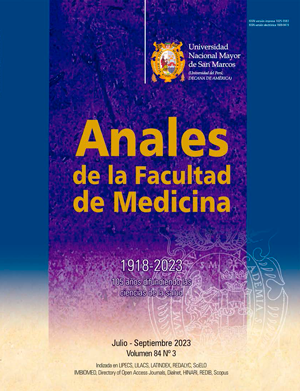Radiodensity of the middle cerebral artery and correlation with the hemoglobin level in patients with and without stroke living at high altitudes
DOI:
https://doi.org/10.15381/anales.v84i3.25464Keywords:
Cerebral Infarction, Tomography, Altitude, Middle Cerebral ArteryAbstract
Introduction. The sign of the hyperdense middle cerebral artery (MCA) evaluated by simple tomography allows predicting ischemic cerebrovascular disease (ICD) with occlusion of a large vessel, however, it is common to identify this sign in residents with high hemoglobin levels without symptoms of ICD. Objectives. To evaluate the correlation between the radiodensity of the MCA and the hemoglobin level in patients with and without ICD, residing in a high-altitude city. Methods. Analytical observational study, including people residing in Cusco (located at 3300 masl) who attended the emergency service and underwent a brain tomography, presenting or not ICD symptoms. ACM radiodensity was measured and correlated with the hemoglobin level. Results. 279 patients were included, the average hemoglobin was 15.1 and standard deviation (DE) of 2.5 mg/dL, in the controls a significant correlation was identified (r = 0.425, p<0.01) between the radiodensity of the MCA with the hemoglobin level. In the cases with right ICD, the radiodensity of the right MCA was 46.9 (DE = 7.7 HU) and of the left it was 46.1 (DE = 6.6 HU), with no statistical differences (p=0 ,24). No differences were found in the cases with left ICD either. Conclusion. There is a correlation between the radiodensity of the MCA with the hemoglobin level in the inhabitants who live at high altitudes, however, it is not possible to demonstrate significant differences between the radiodensity between the affected MCA and the contralateral one in the cases of an ICD.
Downloads
Published
Issue
Section
License
Copyright (c) 2023 Anales de la Facultad de Medicina

This work is licensed under a Creative Commons Attribution-NonCommercial-ShareAlike 4.0 International License.
Those authors who have publications with this magazine accept the following terms:
- Authors will retain their copyrights and guarantee the journal the right of first publication of their work, which will be simultaneously subject to Creative Commons Attribution License that allows third parties to share the work as long as its author and its first publication this magazine are indicated.
- Authors may adopt other non-exclusive licensing agreements for the distribution of the version of the published work (eg, deposit it in an institutional electronic file or publish it in a monographic volume) provided that the initial publication in this magazine is indicated.
- Authors are allowed and recommended to disseminate their work over the Internet (eg: in institutional telematic archives or on their website) before and during the submission process, which It can produce interesting exchanges and increase quotes from the published work. (See El efecto del acceso abierto ).















